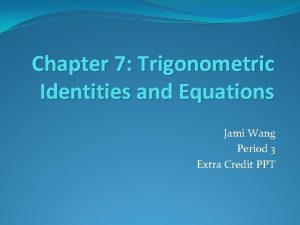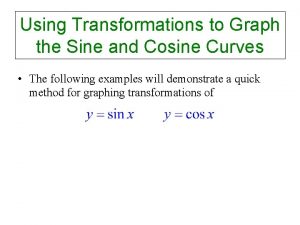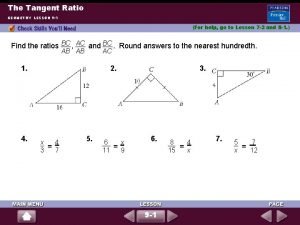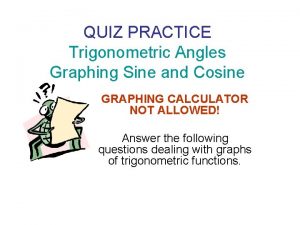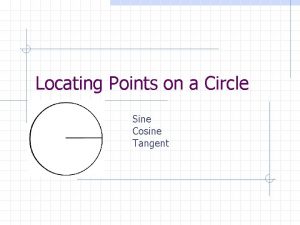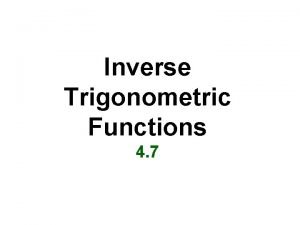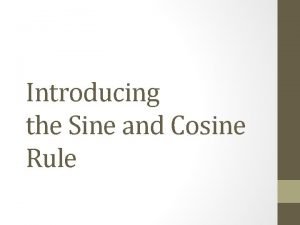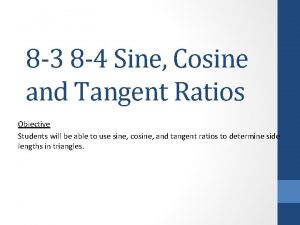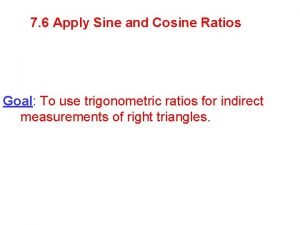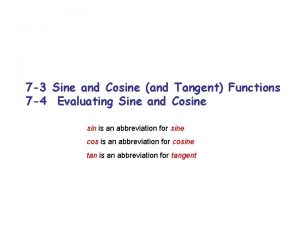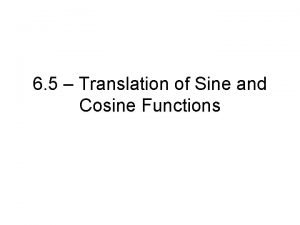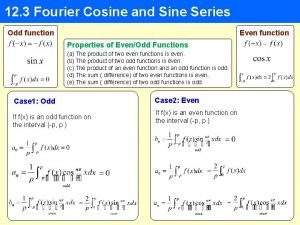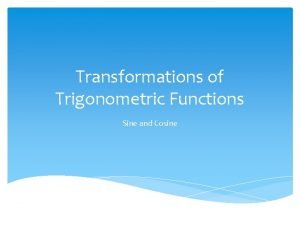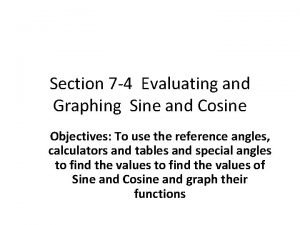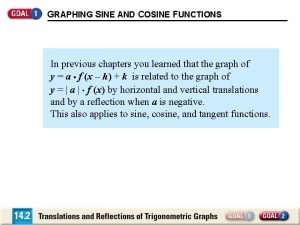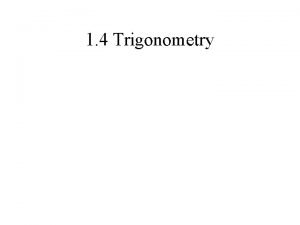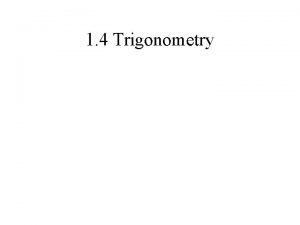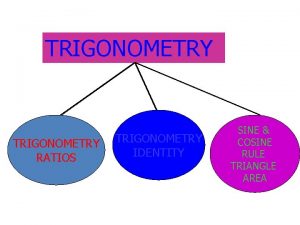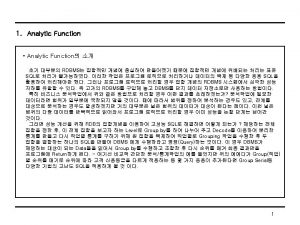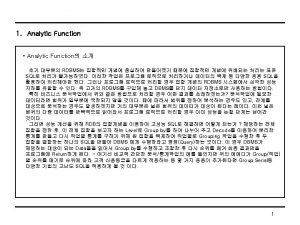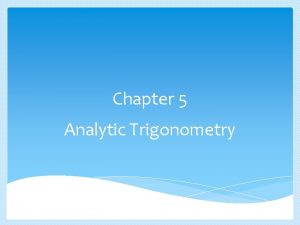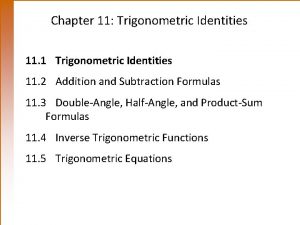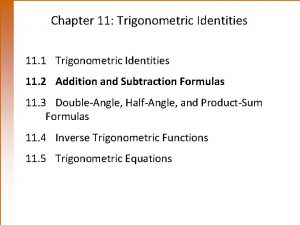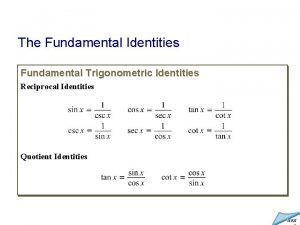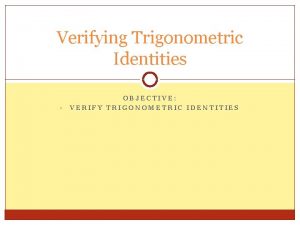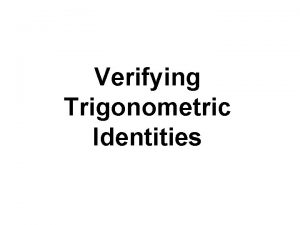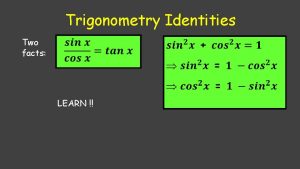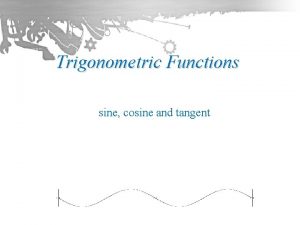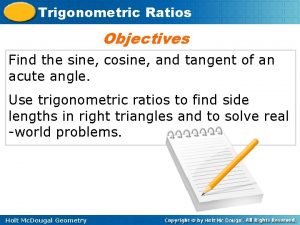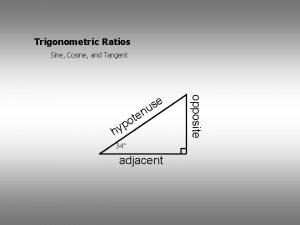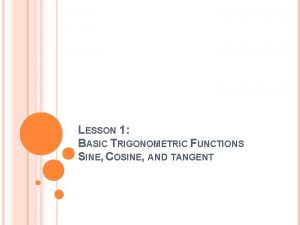ANALYTIC TRIGONOMETRY CHAPTER CONTENTS Trigonometric Identities Cosine Sine



























- Slides: 27

ANALYTIC TRIGONOMETRY

CHAPTER CONTENTS Trigonometric Identities Cosine, Sine, and Tangent of the Sum and Difference of Two angles PROOFS: Cosine of the Sum and Difference of Two Angles Sine of the Sum and Difference of Two Angles Tangent of the Sum and Difference of Two Angles

TRIGONOMETRIC IDENTITIES Recall the definitions of the reciprocal trigonometric functions csc θ, sec θ and cot θ from the trigonometric functions.

Now, consider the following diagram where the point (x, y) defines an angle θ at the origin, and the distance from the origin to the point is r units: Now, we use these results to find an important definition for tan θ: Now, also so we can conclude that: From the diagram, we can see that the ratios sin θ and cos θ are defined as: and

Also, for the values in the diagram, we can use Pythagoras' Theorem and obtain: Dividing through gives us: so we obtain the important result:

We now proceed to derive two other related formulas that can be used when proving trigonometric identities. It is suggested that you remember how to find the identities, rather than try to memorize each one. Dividing through by gives us:

EXAMPLE #1 Answer EXAMPLE #2 Answer

EXAMPLE #1 EXAMPLE #2 Answer

EXAMPLE #1 EXAMPLE #2 Home

EXAMPLE #1 Answer EXAMPLE #2

SIN, COS AND TAN OF SUM AND DIFFERENCE OF TWO ANGLES The sine of the sum and difference of two angles is as follows: The cosine of the sum and difference of two angles is as follows: The tangent of the sum and difference of two angles is as follows:

Cosine of the Sum and Difference of Two Angles We will prove the cosine of the sum of two angles identity first, and then show that this result can be extended to all the other identities given.

Cosine of the Sum and Difference of Two Angles We draw a circle with radius 1 unit, with point P on the circumference at (1, 0). We draw an angle α from the centre with terminal point Q at (cos α, sin α), as shown. [Q is (cos α, sin α) because the hypotenuse is 1 unit. ]

Cosine of the Sum and Difference of Two Angles We extend this idea by drawing: • The angle β with terminal points at Q (cos α, sin α) and R (cos (α + β), sin (α + β)) • The angle -β with terminal point at S (cos (-β), sin (-β)) • The lines PR and QS, which are equivalent in length.

Cosine of the Sum and Difference of Two Angles Now, using the distance formula, we have:

Cosine of the Sum and Difference of Two Angles Now, using the distance formula on distance QS: [since cos(-β) = cos β (cosine is an even function) and sin(-β) = -sinβ (sine is an odd function]

Cosine of the Sum and Difference of Two Angles Since PR = QS, we can equate the 2 distances we just found: If we replace β with (-β), this identity becomes: Home

Sine of the Sum and Difference of Two Angles We will prove the sine of the sum of two angles identity.

Sine of the Sum and Difference of Two Angles Recall that: If θ = α + β, then we have:

Sine of the Sum and Difference of Two Angles Next, we re-group the angles inside the cosine term, since we need this for the rest of the proof: Using the cosine of the difference of 2 angles identity that we just found above [which said cos (α − β) = cos α cos β + sin α sin β], we have:

Sine of the Sum and Difference of Two Angles Therefore: Replacing β with (-β), this identity becomes Home

Tangent of the Sum and Difference of Two Angles We will prove the tangent of the sum of two angles identity.

Tangent of the Sum and Difference of Two Angles Recall that: So, letting θ = α + β, and expanding using our new sine and cosine identities, we have:

Tangent of the Sum and Difference of Two Angles Replacing β with (-β) gives us Title

Recall the Phythagorean Theorem: For a right-angled triangle with hypotenuse length c,

We use this to find the distance between any two points (x 1, y 1) and (x 2, y 2) on the cartesian plane: The point (x 2, y 1) is at the right angle. We can see that: • The distance between the points (x 1, y 1) and (x 2, y 1) is simply x 2 − x 1 • The distance between the points (x 2, y 2) and (x 2, y 1) is simply y 2 − y 1. Using Pythagoras' Theorem we have the distance between (x 1, y 1) and (x 2, y 2) given by: Cosine

ANALYTIC TRIGONOMETRY
 Analytic trigonometry calculator
Analytic trigonometry calculator Tan 240⁰
Tan 240⁰ Inverse trigonometry
Inverse trigonometry Sine and cosine graphs
Sine and cosine graphs Magic triangles trigonometry
Magic triangles trigonometry How to find period of a sin graph
How to find period of a sin graph Practice 9-1 the tangent ratio answers
Practice 9-1 the tangent ratio answers Sine rule cosine rule
Sine rule cosine rule Sine and cosine law maze
Sine and cosine law maze Sohcahtoa practice
Sohcahtoa practice 9-5 practice graphing trigonometric functions
9-5 practice graphing trigonometric functions Cosine formula
Cosine formula Sine cosine tangent circle
Sine cosine tangent circle 4-4 graphing sine and cosine functions worksheet answers
4-4 graphing sine and cosine functions worksheet answers Inverse of sin
Inverse of sin Sine rule and cosine rule
Sine rule and cosine rule Sinusoidal equation
Sinusoidal equation Cosine word problems
Cosine word problems Sine, cosine, and tangent
Sine, cosine, and tangent Sine and cosine ratios
Sine and cosine ratios Sin quadrants
Sin quadrants 6-5 practice translations of sine and cosine functions
6-5 practice translations of sine and cosine functions Fourier transform odd function
Fourier transform odd function Sine cosine partner
Sine cosine partner Normal sin graph
Normal sin graph Trig graph
Trig graph Graph of sine and cosine functions
Graph of sine and cosine functions Phase shift
Phase shift

